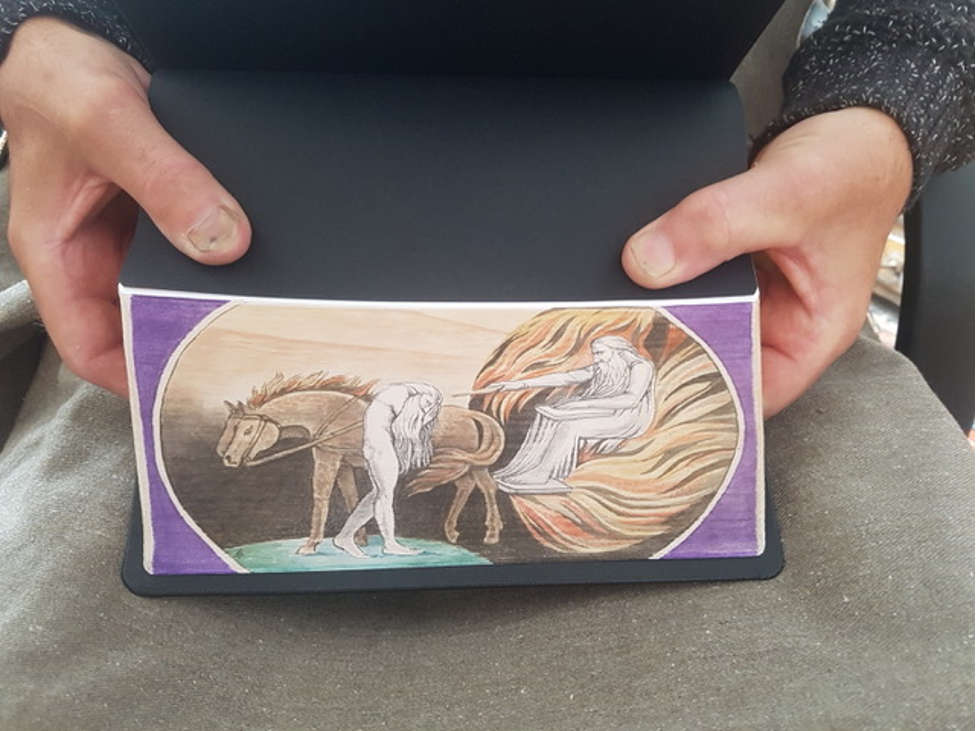Fore-edge Paintings
A fore-edge painting by Martin Frost of William Blake’s God Judging Adam
(relief etching, printed in color and finished with pen, ink and watercolor), c. 1775.
Metropolitan Museum of Art, New York.
(Listen to an audio version of the blog post above!)
As many of your know, I’m something of a bibliophile, a lover of books. I have had many rare books in my library, including a number of Medieval manuscripts and one of my favorites (given to me by my wife, Lynette, in the 1980s), a pamphlet printed in Edinburgh, c. 1799, titled: A Dreadful Example for Wicked Husbands, or the Virtuous Wife in Distress. That one is framed, and it hangs on the wall in my study!
I’ve written a blog on “The Canon of Scripture, Part 1,” which has as its frontispiece a photo of the Gutenberg Bible, c. 1455, the first large-scale book printed in England on a movable-type press, and one of only twelve surviving copies printed on vellum. It resides at the Huntington Library in San Marino, California. The last sale of a complete 2-volume Gutenberg (on paper) sold in 1978 for $2.2 million, a lone volume later sold in 1987 for $5.4 million, and if a complete 2-volume copy emerged today, it would easily fetch $35-50 million at auction.
Book collecting can be expensive!
Sadly, such purchases are way out of my league, so I have settled for far less expensive volumes in niche categories. One such category that has always fascinated me is disappearing fore-edge paintings. Disappearing fore-edge paintings are scenes painted on the fanned edges of a book, and when the book is closed, the painting disappears! The earliest signed example dates back to the mid-seventeenth century, a Bible with the family’s coat of arms on the disappearing fore-edge. They became all the rage in the eighteenth century, and continued in popularity in the nineteenth century and into the early twentieth century. Today, fore-edge painting is a lost art, and few people know anything about it. Indeed, Martin Frost is the only artist in the entire word who works as a full-time, professional fore-edge painter.
I always wanted to add a fore-edge painting to my library, so I contacted Martin Frost in England and commissioned one! I bought a beautiful new copy of the Bible, published by Cambridge University Press, bound in Moroccan leather, with gilt edges (a requirement for a fore-edge painting, for the gilding is what “hides” the painting when the book is closed). The painting I chose to have Martin put on the long fore-edge is William Blake’s, God Judging Adam, the original of which is in the Metropolitan Museum of Art in New York (a second painting of the same scene is in the Tate in London).
Martin and I corresponded back and forth, and I shipped him my Cambridge University Press Bible. He just completed the work today, and he sent it to me from England by FedEx. It should arrive next week. I’m tickled pink!
Martin has a wonderful video on YouTube titled: How Fore-edge Paintings Are Done, a Master Class https://www.youtube.com/watch?v=0x8ihoBaDtI&t=280s. You can see Martin’s entire catalogue of finished fore-edge paintings here: https://www.foredgefrost.co.uk. Treat yourself to this whimsical vanishing art by contacting Martin Frost directly: martin.frost2@ntlworld.com, and add a fore-edge painting to your collection. It will surely make a wonderful conversation piece!

